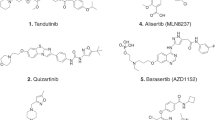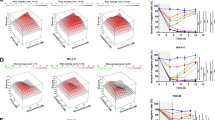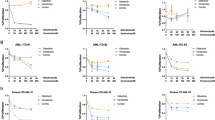Abstract
Acquired resistance to selective FLT3 inhibitors is an emerging clinical problem in the treatment of FLT3-ITD+ acute myeloid leukaemia (AML). The paucity of valid pre-clinical models has restricted investigations to determine the mechanism of acquired therapeutic resistance, thereby limiting the development of effective treatments. We generated selective FLT3 inhibitor-resistant cells by treating the FLT3-ITD+ human AML cell line MOLM-13 in vitro with the FLT3-selective inhibitor MLN518, and validated the resistant phenotype in vivo and in vitro. The resistant cells, MOLM-13-RES, harboured a new D835Y tyrosine kinase domain (TKD) mutation on the FLT3-ITD+ allele. Acquired TKD mutations, including D835Y, have recently been identified in FLT3-ITD+ patients relapsing after treatment with the novel FLT3 inhibitor, AC220. Consistent with this clinical pattern of resistance, MOLM-13-RES cells displayed high relative resistance to AC220 and Sorafenib. Furthermore, treatment of MOLM-13-RES cells with AC220 lead to loss of the FLT3 wild-type allele and the duplication of the FLT3-ITD-D835Y allele. Our FLT3-Aurora kinase inhibitor, CCT137690, successfully inhibited growth of FLT3-ITD-D835Y cells in vitro and in vivo, suggesting that dual FLT3-Aurora inhibition may overcome selective FLT3 inhibitor resistance, in part due to inhibition of Aurora kinase, and may benefit patients with FLT3-mutated AML.
This is a preview of subscription content, access via your institution
Access options
Subscribe to this journal
Receive 12 print issues and online access
$259.00 per year
only $21.58 per issue
Buy this article
- Purchase on Springer Link
- Instant access to full article PDF
Prices may be subject to local taxes which are calculated during checkout





Similar content being viewed by others
References
Smith ML, Hills RK, Grimwade D . Independent prognostic variables in acute myeloid leukaemia. Blood Rev 2010; 25: 39–51.
Meshinchi S, Appelbaum FR . Structural and functional alterations of FLT3 in acute myeloid leukemia. Clin Cancer Res 2009; 15: 4263–4269.
Whitman SP, Archer KJ, Feng L, Baldus C, Becknell B, Carlson BD et al. Absence of the wild-type allele predicts poor prognosis in adult de novo acute myeloid leukemia with normal cytogenetics and the internal tandem duplication of FLT3: a cancer and leukemia group B study. Cancer Res 2001; 61: 7233–7239.
Meshinchi S, Alonzo TA, Stirewalt DL, Zwaan M, Zimmerman M, Reinhardt D et al. Clinical implications of FLT3 mutations in pediatric AML. Blood 2006; 108: 3654–3661.
Mead AJ, Linch DC, Hills RK, Wheatley K, Burnett AK, Gale RE . FLT3 tyrosine kinase domain mutations are biologically distinct from and have a significantly more favorable prognosis than FLT3 internal tandem duplications in patients with acute myeloid leukemia. Blood 2007; 110: 1262–1270.
Whitman SP, Ruppert AS, Radmacher MD, Mrozek K, Paschka P, Langer C et al. FLT3 D835/I836 mutations are associated with poor disease-free survival and a distinct gene-expression signature among younger adults with de novo cytogenetically normal acute myeloid leukemia lacking FLT3 internal tandem duplications. Blood 2008; 111: 1552–1559.
Knapper S . The clinical development of FLT3 inhibitors in acute myeloid leukemia. Expert Opin Investig Drugs 2011; 20: 1377–1395.
Levis MJ . Will newer tyrosine kinase inhibitors have an impact in AML? Best Pract Res Clin Haematol 2010; 23: 489–494.
Smith CC, Chin J, Wang Q, Salerno S, Damon LE, Hunt JP et al. Validation of FLT3-ITD as a therapeutic target in human acute myeloid leukemia. Blood (ASH Annual Meeting Abstracts) 2011; 118 (abstract 937).
Carmena M, Earnshaw WC . The cellular geography of aurora kinases. Nat Rev Mol Cell Biol 2003; 4: 842–854.
Moore AS, Blagg J, Linardopoulos S, Pearson AD . Aurora kinase inhibitors: novel small molecules with promising activity in acute myeloid and Philadelphia-positive leukemias. Leukemia 2010; 24: 671–678.
Girdler F, Gascoigne KE, Eyers PA, Hartmuth S, Crafter C, Foote KM et al. Validating Aurora B as an anti-cancer drug target. J Cell Sci 2006; 119: 3664–3675.
Carpinelli P, Moll J . Aurora kinase inhibitors: identification and preclinical validation of their biomarkers. Expert Opin Ther Targets 2008; 12: 69–80.
Vader G, Medema RH, Lens SM . The chromosomal passenger complex: guiding Aurora-B through mitosis. J Cell Biol 2006; 173: 833–837.
Lowenberg B, Muus P, Ossenkoppele G, Rousselot P, Cahn JY, Ifrah N et al. Phase I/II study to assess the safety, efficacy, and pharmacokinetics of barasertib (AZD1152) in patients with advanced acute myeloid leukemia. Blood 2011; 118: 6030–6036.
Goldberg SL, Fenaux P, Craig MD, Gyan E, Lister J, Kassis J et al. Phase 2 study of MLN8237, an investigational Aurora A kinase (AAK) inhibitor in patients with acute myelogenous leukemia (AML) or myelodysplastic syndromes (MDS). Blood (ASH Annual Meeting Abstracts) 2010; 116 (abstract 3273).
Bavetsias V, Large JM, Sun C, Bouloc N, Kosmopoulou M, Matteucci M et al. Imidazopyridine derivatives as inhibitors of Aurora kinases: lead optimization studies toward the identification of an orally bioavailable preclinical development candidate. J Med Chem 2010; 53: 5213–5228.
Bavetsias V, Sun C, Bouloc N, Reynisson J, Workman P, Linardopoulos S et al. Hit generation and exploration: imidazopyridine derivatives as inhibitors of Aurora kinases. Bioorg Med Chem Lett 2007; 17: 6567–6571.
Chan F, Sun C, Perumal M, Nguyen QD, Bavetsias V, McDonald E et al. Mechanism of action of the Aurora kinase inhibitor CCT129202 and in vivo quantification of biological activity. Mol Cancer Ther 2007; 6: 3147–3157.
Drexler HG . Guide to Leukemia-Lymphoma Cell Lines, 2nd edn. Braunschweig, 2010.
Murphy KM, Levis M, Hafez MJ, Geiger T, Cooper LC, Smith BD et al. Detection of FLT3 internal tandem duplication and D835 mutations by a multiplex polymerase chain reaction and capillary electrophoresis assay. J Mol Diagn 2003; 5: 96–102.
Workman P, Aboagye EO, Balkwill F, Balmain A, Bruder G, Chaplin DJ et al. Guidelines for the welfare and use of animals in cancer research. Br J Cancer 2010; 102: 1555–1577.
Smith CC, Damon L, Salerno S, Shah NP . Saturation mutagenesis of FLT3-ITD: AC220-resistance-conferring kinase domain mutations are restricted to a limited number of residues and are cross-resistant to sorafenib in vitro. Am Assoc Cancer Res (AACR) Meeting Abstracts 2011 (abstract 4737).
Quentmeier H, Reinhardt J, Zaborski M, Drexler HG . FLT3 mutations in acute myeloid leukemia cell lines. Leukemia 2003; 17: 120–124.
Rosnet O, Stephenson D, Mattei MG, Marchetto S, Shibuya M, Chapman VM et al. Close physical linkage of the FLT1 and FLT3 genes on chromosome 13 in man and chromosome 5 in mouse. Oncogene 1993; 8: 173–179.
Kiyoi H, Shiotsu Y, Ozeki K, Yamaji S, Kosugi H, Umehara H et al. A novel FLT3 inhibitor FI-700 selectively suppresses the growth of leukemia cells with FLT3 mutations. Clin Cancer Res 2007; 13: 4575–4582.
Mizuki M, Fenski R, Halfter H, Matsumura I, Schmidt R, Müller C et al. Flt3 mutations from patients with acute myeloid leukemia induce transformation of 32D cells mediated by the Ras and STAT5 pathways. Blood 2000; 96: 3907–3914.
Zarrinkar PP, Gunawardane RN, Cramer MD, Gardner MF, Brigham D, Belli B et al. AC220 is a uniquely potent and selective inhibitor of FLT3 for the treatment of acute myeloid leukemia (AML). Blood 2009; 114: 2984–2992.
Clark JJ, Cools J, Curley DP, Yu JC, Lokker NA, Giese NA et al. Variable sensitivity of FLT3 activation loop mutations to the small molecule tyrosine kinase inhibitor MLN518. Blood 2004; 104: 2867–2872.
von Bubnoff N, Engh RA, Aberg E, Sanger J, Peschel C, Duyster J . FMS-like tyrosine kinase 3-internal tandem duplication tyrosine kinase inhibitors display a nonoverlapping profile of resistance mutations in vitro. Cancer Res 2009; 69: 3032–3041.
Smith CC, Damon LE, Zhu X, Salerno S, Shah N . Analysis of in vitro activity of the clinically-active ABL/FLT3 inhibitor Ponatinib (AP24534) against AC220-resistant FLT3-ITD mutants. Blood (ASH Annual Meeting Abstracts) 2011; 118 (abstract 930).
Smith CC, Perl AE, Lasater E, Zhang C, Jeschke GR, Damon LE et al. PLX3397 is an investigational selective FLT3 inhibitor that retains activity against the clinically-relevant FLT3-ITD/F691 L ‘gatekeeper’ mutation in vitro. Blood (ASH Annual Meeting Abstracts) 2011; 118 (abstract 764).
Fiskus W, Smith CC, Smith J, Wise SC, Lasater E, Damon LE et al. Activity of allosteric, switch-pocket, ABL/FLT3 kinase inhibitor DCC2036 against cultured and primary aml progenitors with FLT-ITD or FLT3 kinase domain mutations. Blood (ASH Annual Meeting Abstracts) 2011; 118 (abstract 2611).
Heidel F, Solem FK, Breitenbuecher F, Lipka DB, Kasper S, Thiede MH et al. Clinical resistance to the kinase inhibitor PKC412 in acute myeloid leukemia by mutation of Asn-676 in the FLT3 tyrosine kinase domain. Blood 2006; 107: 293–300.
Shih LY, Huang CF, Wu JH, Lin TL, Dunn P, Wang PN et al. Internal tandem duplication of FLT3 in relapsed acute myeloid leukemia: a comparative analysis of bone marrow samples from 108 adult patients at diagnosis and relapse. Blood 2002; 100: 2387–2392.
Pratz KW, Sato T, Murphy KM, Stine A, Rajkhowa T, Levis M . FLT3-mutant allelic burden and clinical status are predictive of response to FLT3 inhibitors in AML. Blood 2010; 115: 1425–1432.
Raghavan M, Smith LL, Lillington DM, Chaplin T, Kakkas I, Molloy G et al. Segmental uniparental disomy is a commonly acquired genetic event in relapsed acute myeloid leukemia. Blood 2008; 112: 814–821.
Li L, Bailey E, Greenblatt S, Huso D, Small D . Loss of the wild-type allele contributes to myeloid expansion and disease aggressiveness in FLT3/ITD knockin mice. Blood 2011; 118: 4935–4945.
Thiede C, Steudel C, Mohr B, Schaich M, Schakel U, Platzbecker U et al. Analysis of FLT3-activating mutations in 979 patients with acute myelogenous leukemia: association with FAB subtypes and identification of subgroups with poor prognosis. Blood 2002; 99: 4326–4335.
Chen W, Jones D, Medeiros LJ, Luthra R, Lin P . Acute myeloid leukaemia with FLT3 gene mutations of both internal tandem duplication and point mutation type. Br J Haematol 2005; 130: 726–728.
Carnicer MJ, Nomdedeu JF, Lasa A, Estivill C, Brunet S, Aventin A et al. FLT3 mutations are associated with other molecular lesions in AML. Leuk Res 2004; 28: 19–23.
Acknowledgements
We acknowledge NHS funding to the NIHR Biomedical Research Centre. This work, and all authors from Cancer Research UK Cancer Therapeutics Unit, are supported by core funding from Cancer Research UK (Grant numbers C309/A8274, C309/A11566). ASM is supported by Cancer Research UK (Grant number C1178/A10294) and in part by a New Investigator Scholarship awarded by the Haematology Society of Australia and New Zealand. ADJP is supported by Cancer Research UK (Programme Grant C1178/A10294). PW is a Cancer Research UK Life Fellow. SL is also supported by Breakthrough Breast Cancer.
Author information
Authors and Affiliations
Corresponding author
Ethics declarations
Competing interests
All authors are employees of the Institute of Cancer Research, which has a commercial interest in drug development programmes (see www.icr.ac.uk). Please note that all authors who are, or have been, employed by the Institute of Cancer Research are subject to a ‘Rewards to Inventors Scheme’, which may reward contributors to a programme that is subsequently licensed.
Additional information
Supplementary Information accompanies the paper on the Leukemia website
Supplementary information
Rights and permissions
About this article
Cite this article
Moore, A., Faisal, A., de Castro, D. et al. Selective FLT3 inhibition of FLT3-ITD+ acute myeloid leukaemia resulting in secondary D835Y mutation: a model for emerging clinical resistance patterns. Leukemia 26, 1462–1470 (2012). https://doi.org/10.1038/leu.2012.52
Received:
Accepted:
Published:
Issue Date:
DOI: https://doi.org/10.1038/leu.2012.52
Keywords
This article is cited by
-
Blockade of de novo pyrimidine biosynthesis triggers autophagic degradation of oncoprotein FLT3-ITD in acute myeloid leukemia
Oncogene (2023)
-
Autophagy activation mediates resistance to FLT3 inhibitors in acute myeloid leukemia with FLT3-ITD mutation
Journal of Translational Medicine (2022)
-
Translatome proteomics identifies autophagy as a resistance mechanism to on-target FLT3 inhibitors in acute myeloid leukemia
Leukemia (2022)
-
Mutated clones driving leukemic transformation are already detectable at the single-cell level in CD34-positive cells in the chronic phase of primary myelofibrosis
npj Precision Oncology (2021)
-
Inhibition of translation initiation factor eIF4a inactivates heat shock factor 1 (HSF1) and exerts anti-leukemia activity in AML
Leukemia (2021)



